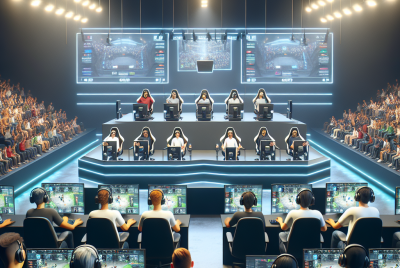Will Virtual Reality Replace Traditional Gaming?
Will Virtual Reality Replace Traditional Gaming?
Understanding Virtual Reality in Gaming
Virtual Reality (VR) gaming has swiftly evolved from an ambitious concept to a burgeoning industry, capturing the enthusiasm of gamers and developers alike. At its core, VR immerses players in a digitally-created environment, allowing them to interact with 3D worlds through ocular devices and motion tracking. This level of immersion presents an engaging alternative to traditional gaming, which typically relies on two-dimensional screens and standard controllers.
The technology driving VR forward includes powerful graphics cards, high-resolution displays, and sophisticated sensors that track head movements. These advancements have enhanced user experience, providing players with realistic interactions within game worlds. However, despite VR’s impressive capabilities, many still question whether it can fully replace traditional gaming.
The Appeal of Traditional Gaming
Traditional gaming has long been the backbone of the entertainment industry, offering a wide array of genres, from action-adventure to role-playing games (RPGs). With accessible platforms such as consoles, PCs, and smartphones, traditional gaming is available to a diverse audience. Furthermore, traditional games often feature rich narratives, complex mechanics, and social interactions through competitive or cooperative play.
Many gamers appreciate traditional gaming for its simplicity and ease of access. No need for additional equipment—just a console and a controller will suffice. Moreover, the costs associated with traditional gaming are relatively lower compared to VR setups, which often require a powerful gaming PC or dedicated VR headset, sometimes exceeding a thousand dollars.
VR vs. Traditional Gaming: The Technological Divide
When evaluating whether VR will replace traditional gaming, one must consider the differing technological requirements and experiences offered by each.
- Immersion and Experience
- VR provides a level of immersion unattainable in traditional gaming. Gamers using a VR headset can turn their heads and physically move through the game space, creating a sense of presence. Titles such as “Beat Saber” and “Half-Life: Alyx” exemplify immersive gameplay where physical movements directly influence outcomes in the game.
- Hardware Limitations
- Traditional gaming has a far lower barrier to entry compared to VR. A standard gaming console or PC setup is often sufficient for traditional titles, while VR gaming may necessitate high-end hardware, including advanced graphics cards and specialized peripherals. Consequently, while VR enhances experience, it also complicates accessibility.
- Physical Limitations and Health Concerns
- Extended periods in VR can lead to discomfort, including motion sickness and fatigue. Users must engage in physically demanding actions, which can deter casual players. In contrast, traditional gaming allows for longer play sessions without as many physical consequences.
- Content Availability
- The library of traditional games is vast, with countless options available across genres. Conversely, VR gaming is still in its infancy regarding content diversity. Many VR titles focus on shorter experiences or niche genres, limiting broad appeal.
The Social Aspect of Gaming
Social interaction is vital in gauging the popularity of any gaming format. Traditional gaming has thrived on shared experiences, whether through local multiplayer sessions, online connections, or social media engagement. Games like “Fortnite” and “Call of Duty” have created communities that value competitiveness and camaraderie.
VR is beginning to carve its niche in social gaming, with platforms such as VRChat allowing users to interact within virtual environments. However, the social dynamics in VR can feel less organic due to physical isolation and the challenging logistics of virtual gatherings. While advancements in social VR are being made, traditional gaming continues to lead in creating accessible social experiences.
The Future of VR and Traditional Gaming
While skeptics of VR may claim that it cannot completely replace traditional gaming, it is clear that these two formats can coexist, each catering to different segments of the gaming community. Here are potential scenarios for the future:
- Hybrid Experiences: The industry might see an upsurge in hybrid games that blend elements of both VR and traditional gameplay. Innovations could include augmented reality (AR) integration, where players use VR in conjunction with real-world environments, analogous to games like “Pokémon Go”.
- Expanding Content Libraries: As technology advances, VR developers will likely increase their focus on creating robust narratives and more diverse game types to compete with traditional formats. Increased content availability could drive further interest in VR, making it a more viable alternative to traditional gaming.
- Cultural Shift: The gaming community’s culture may gradually adapt to embrace VR as an appealing alternative. As younger generations grow up with advanced gaming technologies, an inherent focus on immersiveness could shift preferences toward VR.
Conclusion: Coexistence Instead of Replacement
Realistically, VR is unlikely to wholly replace traditional gaming, as each has its strengths and appeal. Traditional gaming will continue to support casual and competitive gamers, while VR will likely gain traction for those seeking immersive experiences. Consumer habits and industry developments will shape the relationship between these two gaming forms, leading to exciting innovations that leverage the strengths of both.
SEO Considerations
To optimize for relevant keywords, including phrases like “VR gaming”, “traditional gaming”, “future of gaming”, “immersive gaming experiences”, and “VR game development” can be beneficial. Organic traffic can be further enhanced with internal and external links to authoritative sources on VR technologies and traditional gaming statistics. Interacting with user-generated content and forums around gaming can broaden reach and engagement, thus increasing visibility in search engines.
Final Thoughts
As the gaming landscape evolves, a blend of traditional and VR elements may pave the way for a new generation of gameplay experiences. The future remains uncertain, but one thing is clear: both traditional and virtual reality gaming will continue to play significant roles in shaping how we interact with digital worlds. Ultimately, the choice will lie in player preference, accessibility, and the evolution of technology.




